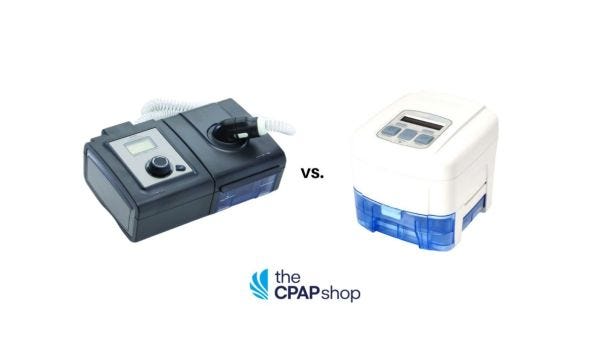Phillips Respironics PR System One Pro vs. Devilbiss IntelliPAP BiLevel S
Continue reading for a comparison guide for BiPAP machines. If you were recently diagnosed with Sleep Apnea and prescribed a BiPAP machine by your physician, the good news is that technology has advanced significantly in the past few years. However, BiPAP machines are generally more expensive than a standard CPAP machine.
A Brief Summary of BiPAP Machines/VPAP Machines/BiLevel Machines
Although BiPAP or BiLevel machines function similarly to standard CPAP’s during inhalation(IPAP), it differs on the exhalation pressure (EPAP). BiPAP machines deliver a pressure relief during exhalation to allow for patients to breathe more comfortably. Because BiPAP machines are generally used for sleep apnea patients with higher than average pressure – typically 15cm and over, this exhalatory pressure relief is especially noticeable to patients by allowing them to exhale without struggling against a strong constant pressure.
A sleep study will determine the differential in IPAP and EPAP pressures or pressure support. In fact, the EPAP pressure of a BiPAP machine can reduce to the machine's lowest setting of 4cm while the IPAP can be 15cm or higher. BiPAP machines are particularly helpful for patients with coexisting lung disease and those with excessive levels of carbon dioxide. This function provides for a more comfortable CPAP experience and, thus, a higher compliance rate.
BiPAP machines usually operate in three different modes, which increases the degree of functionality and allows for use with a greater variety of breathing difficulties.
- Spontaneous - switching between inspiratory and expiratory as the BiPAP machine senses the switch in breathing.
- Timed - switching between inspiratory and expiratory at a programmed rate to ensure the prescribed breaths per minute rate is maintained.
- Spontaneous/Timed(ST) - switches as it senses the change in breathing. Timed mode functions as a failsafe to ensure breathing at the required breathes per minute rate is maintained.
Philips Respironics PR One BiPAP PRO vs. Devilbiss IntelliPAP BiLevel S Comparison
Because the Respironics PR System One BiPAP Pro and the Devilbiss IntelliPAP BiLevel S are spontaneous BiPAP machines, there are a few obvious similarities. Each BiPAP sleep therapy system has wide pressure ranges (PR one 4-25cm, IntelliPAP 3-25cm). Additionally, the IPAP and EPAP differential can be as great as 22cm. Both are able to operate in either the standard BiPAP or CPAP mode. As typical with BiPAP machines, ramps are adjustable, altitude adjustment is automatic and each has optional integrated heated humidifiers.
Both have exceptionally small footprints which fit easily onto a night table or into carry-on luggage. The Devilbiss IntelliPAP BiPAP machine weighs 4.45lbs including the humidifier and has dimensions of 6.5” x 8.4” x 6.4”. The PR One Pro BiPAP machine weighs in at 4.85lbs including humidifier and with dimensions of 7" x 10.75"x 4". In essence, the Devilbiss IntelliPAP is a cube while the PR One BiPAP Pro is rectangular.
Functionally, both the PR System One BiPAP Pro and the IntelliPAP BiLevel S BiPAP machines detect the most important aspects of BiPAP sleep therapy. These include Apnea and Hypopnea events, Leak Detection and Compensation, Breath Rate, and other respiratory events. Additionally, each system is able to record and download each night's sleep therapy diagnostics.
Advanced Technology of Philips Respironics PR One BiPAP PRO and Devilbiss IntelliPAP BiLevel S
This is where the BiPAP machines begin to differ and the superior technology of Phillips Respironics shines through. DeVilbiss IntelliPAP algorithm includes a function termed Flow-Rounding. Essentially, Flow-Rounding technology is a scalable setting that softens the transition from inhalation to exhalation (IPAP to EPAP). This technology is especially important when the transition or flow ratio between the IPAP and EPAP settings is significant. This comfort feature has become quite popular and adopted by most manufacturers.
The Phillips Respironics PR System One BiPAP machine utilizes similar technology called Bi-Flex. Bi-Flex pressure relief technology offers pressure relief at inhalation and exhalation to make BiPAP machine therapy more like natural breathing. By tracking each breath, Bi-Flex pressure relief technology delivers pressure relief at three critical points in the breathing cycle. These transitions are from exhalation to inhalation, inhalation to exhalation, and during exhalation. Moreover, PR System One Resistance Control achieves complete system comfort by enabling the device and mask to work optimally together.
This technology instructs the device to compensate for variable resistance characteristics related to different masks. The result is synchronous pressure delivery and the assurance patients can enjoy the full benefits of the PR System One’s Flex comfort technologies no matter which mask is used. A humidity control function also prevents condensation in the hose or rainout. By analyzing ambient temperature, relative humidity, and patient flow, the device delivers optimum humidity to the patient while also dramatically reducing rainout.
Finally, the PR System One BiPAP machine addresses advanced sleep assessment parameters including AHI, large leak, flow limitation, and RERAs that help determine appropriate clinical management of obstructive sleep apnea (OSA). Another advancement is the PR System One’s ability to point out when the patient is experiencing symptoms beyond classic OSA and indicate the potential need for specialized therapy. The PR System One can now verify all events by looking at detailed patient flow waveform data captured by the device.
The Final Word on Philips Respironics PR One BiPAP PRO and Devilbiss IntelliPAP BiLevel S BiPAP Machines
Although the BiPAP machines have similarities, the differences, primarily in the technology, make it necessary to understand what is necessary and what is non-essential in a patient's sleep therapy. Clearly, the Phillips Respironics PR System One BiPAP machine is technologically superior to the Devilbiss IntelliPAP. Nevertheless, the more advanced technology does not always present the best value for everyone. Thus, it is essential for patients to understand what is optimal for their sleep therapy and consult with a physician and CPAP equipment supplier to determine the most effective treatment options.




